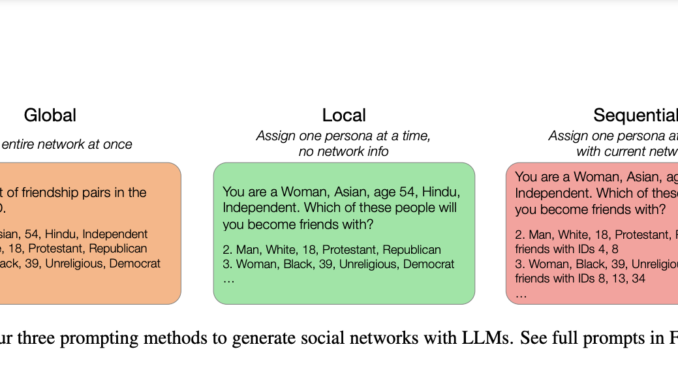
Social network generation finds numerous applications in various fields, such as epidemic modeling, social media simulations, and understanding social phenomena like polarization. Creating realistic social networks is crucial when real networks cannot be directly observed due to privacy concerns or other constraints. These generated networks are vital for accurately modeling interactions and predicting outcomes in these contexts.
A major challenge in social network generation is balancing realism and adaptability. Traditional approaches, such as deep learning models, typically require extensive training on domain-specific networks. These models need help generalizing to new scenarios where data might be sparse or unavailable. Conversely, classical models like Erdös-Rényi and small-world models rely on rigid assumptions about network formation, which often fail to capture the intricate dynamics of real-world social interactions.
Current methods for network generation include a mix of deep learning techniques and classical statistical models. Deep learning models are powerful but require large datasets to learn from, limiting their applicability in settings where such data is unavailable. On the other hand, classical models, while more flexible regarding data requirements, tend to oversimplify the formation of social networks. For example, the Erdös-Rényi model assumes that each connection in a network forms with a uniform probability, which does not align well with how social connections are formed in reality. Similarly, small-world and stochastic block models capture some aspects of social networks but miss out on the complex, nuanced interactions that occur in real life.
Researchers from Stanford University, the University of California and Cornell University have introduced an innovative approach using large language models (LLMs) to generate social networks. Like those developed by OpenAI, LLMs have shown remarkable capabilities in generating human-like text and simulating interactions. The researchers leveraged these capabilities to generate social networks without needing prior training on network data, a process known as zero-shot learning. This approach allows LLMs to create networks based on natural language descriptions of individuals, offering a flexible and scalable solution to the challenges faced by traditional models.
The researchers proposed three distinct prompting techniques to guide the LLMs in generating social networks. The first method, termed the “Global” approach, prompts the LLM to construct the entire network simultaneously, considering all individuals simultaneously. The second method, the “Local” approach, involves building the network one individual at a time, where the LLM assumes the identity of each persona and, in turn, decides who they would likely connect with. Finally, the “Sequential” approach is a variation of the Local method, where the LLM builds the network incrementally, considering previous personas’ connections. This method also incorporates feedback from the developing network structure, allowing for more refined decision-making.
The performance and results of these methods were rigorously evaluated against real-world social networks. The study revealed that the Local and Sequential methods produced networks that closely matched the structural characteristics of actual social networks. For instance, the networks generated using these methods displayed realistic density levels, clustering, and community structure. The researchers observed that the Sequential method, in particular, could replicate long-tail degree distributions—a key feature of real social networks where a few individuals have significantly more connections than others.
The Sequential method showed a substantial improvement in capturing the nuances of social networks. For example, the degree distribution in networks generated by the Sequential method was closer to that of real networks, with a substantially reduced error margin compared to the Global method. However, the study also uncovered a significant bias in the generated networks: the LLMs consistently overemphasized political homophily. The networks exhibited higher-than-expected levels of political affiliation clustering, where individuals were more likely to connect with others who shared their political views. This overestimation was particularly pronounced in networks generated by the Sequential method, where the observed political homophily was up to 85% higher than typically seen in real social networks.
In conclusion, the research conducted by the team from Stanford University demonstrates the potential of using LLMs for social network generation. These models offer a flexible, zero-shot approach to creating realistic social networks, overcoming many of the limitations of traditional methods. However, the study also highlights the challenges associated with biases in LLM-generated networks, particularly concerning political affiliation. As these models continue to evolve, addressing these biases will be crucial for ensuring that the networks they generate are realistic and free from undue influence by the underlying biases in the model’s training data.
Check out the Paper. All credit for this research goes to the researchers of this project. Also, don’t forget to follow us on Twitter and LinkedIn. Join our Telegram Channel.
If you like our work, you will love our newsletter..
Don’t Forget to join our 50k+ ML SubReddit
Nikhil is an intern consultant at Marktechpost. He is pursuing an integrated dual degree in Materials at the Indian Institute of Technology, Kharagpur. Nikhil is an AI/ML enthusiast who is always researching applications in fields like biomaterials and biomedical science. With a strong background in Material Science, he is exploring new advancements and creating opportunities to contribute.





Be the first to comment